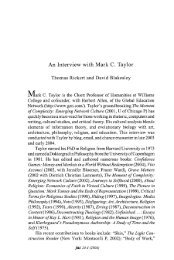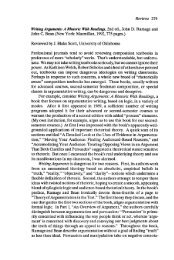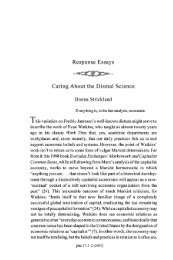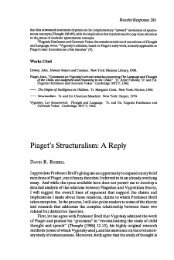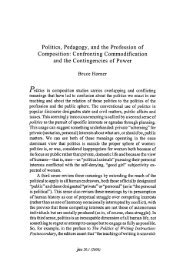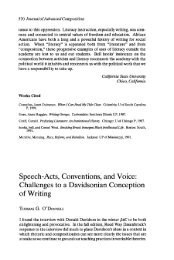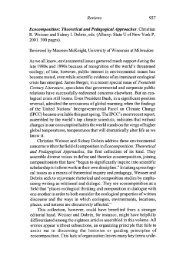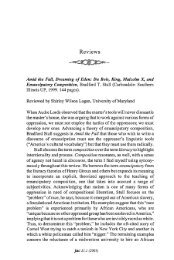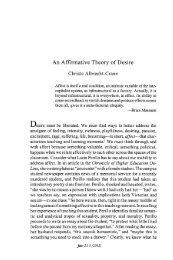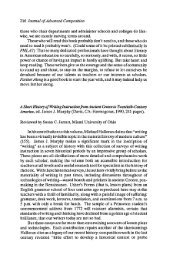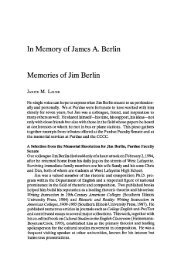Rhetoric in the Classical Tradition by Winifred Bryan ... - JAC Online
Rhetoric in the Classical Tradition by Winifred Bryan ... - JAC Online
Rhetoric in the Classical Tradition by Winifred Bryan ... - JAC Online
Create successful ePaper yourself
Turn your PDF publications into a flip-book with our unique Google optimized e-Paper software.
204 Journal of Advanced Composition<br />
takes <strong>in</strong>to account <strong>the</strong>se new understand<strong>in</strong>gs and broadened conceptions of<br />
classical rhetoric, once def<strong>in</strong>ed ma<strong>in</strong>ly <strong>in</strong> terms of <strong>the</strong> formulaic Ad Herennium.<br />
Unfortunately ,Professor Homer has decided not to write that book. She<br />
does, however, give students her understand<strong>in</strong>g of <strong>the</strong> relationship between<br />
standard classical terms and <strong>the</strong> standard elements of modem academic<br />
writ<strong>in</strong>g-an understand<strong>in</strong>g that offers students "a vocabulary for talk<strong>in</strong>g<br />
about writ<strong>in</strong>g," along with practice, examples, and read<strong>in</strong>gs.<br />
The twenty-page "Introduction to <strong>Classical</strong> <strong>Rhetoric</strong>" that beg<strong>in</strong>s <strong>the</strong><br />
book presents two major uses forrhetoric <strong>in</strong> Antiquity: (I) as a demonstration<br />
of <strong>the</strong> "duty of world citizenship," and (2) as <strong>the</strong> "road to wealth, power, and<br />
<strong>in</strong>fluence. " The debate over whe<strong>the</strong>r rhetoric is a moral force or a tool of<br />
personal ambition cont<strong>in</strong>ues today, and Homer seems to respect both sides:<br />
she says, on <strong>the</strong> one hand, that "through rhetoric, we must cont<strong>in</strong>ue to<br />
exam<strong>in</strong>e moral values and to question right and wrong," and on <strong>the</strong> o<strong>the</strong>r, that<br />
"it was [and is] noth<strong>in</strong>g less than imperative for anyone who aspired to a<br />
position of <strong>in</strong>fluence to learn ... <strong>the</strong> art of rhetoric" (4,2). Thus, Homer's<br />
<strong>in</strong>troduction recalls <strong>the</strong> discussion begun <strong>by</strong> Callicles and Socrates <strong>in</strong> <strong>the</strong><br />
Gorgias; she asks students to understand that "skill with spoken and written<br />
language still br<strong>in</strong>gs power" (2), while <strong>the</strong>y consider <strong>the</strong> different k<strong>in</strong>ds of<br />
power that rhetoric can afford.<br />
Throughout <strong>the</strong> text, Homer <strong>in</strong>troduces potentially unfamiliar terms<br />
associated with classical rhetoric (such as Gorgias, hypocrisis, <strong>in</strong>ventio),<br />
along with <strong>the</strong>ir correct pronunciation. These terms are fur<strong>the</strong>r def<strong>in</strong>ed <strong>in</strong> a<br />
glossary, illustrat<strong>in</strong>g Homer's contention that an "acqua<strong>in</strong>tance with classical<br />
rhetoric and <strong>the</strong> great philosophers who conceived it is part of literacy <strong>in</strong><br />
its fullest sense" (xi). This association of literacy with <strong>the</strong> <strong>in</strong>culcation of a<br />
canonical lexicon recalls classical Roman school<strong>in</strong>g, certa<strong>in</strong>ly, and it also<br />
enters <strong>the</strong> current debate about "cultural literacy" on <strong>the</strong> E.D. HirschI Allan<br />
Bloom side.<br />
<strong>Rhetoric</strong> <strong>in</strong> <strong>the</strong> <strong>Classical</strong> <strong>Tradition</strong> is divided <strong>in</strong>to five parts, correspond<strong>in</strong>g<br />
to <strong>the</strong> canons of Roman rhetoric: <strong>in</strong>vention, arrangement, style, memory,<br />
and presentation. The largest section (seven chapters) treats <strong>in</strong>vention and<br />
<strong>in</strong>cludes an <strong>in</strong>terest<strong>in</strong>g emphasis that will be less apparent to writ<strong>in</strong>g students<br />
than to teachers who identify <strong>in</strong>vention with exploration and discovery.<br />
Homer does not feature <strong>in</strong>vention-as-exploration, as Aristotle does <strong>in</strong> <strong>the</strong><br />
<strong>Rhetoric</strong>, choos<strong>in</strong>g <strong>in</strong>stead <strong>the</strong> Roman identification of <strong>in</strong>vention with<br />
organization or arrangement that we f<strong>in</strong>d <strong>in</strong> <strong>the</strong> Ad H erennium and <strong>the</strong> more<br />
formulaic works of Cicero. For <strong>in</strong>stance, <strong>in</strong> <strong>the</strong> first of two chapters on<br />
"Discover<strong>in</strong>g Ideas," Homer presents "def<strong>in</strong>ition" as "<strong>the</strong> organiz<strong>in</strong>g<br />
pr<strong>in</strong>ciple of a full-length essay" (89); she presents "classification and<br />
division" as "ways of clarify<strong>in</strong>g a subject for a reader" (99), and equates<br />
<strong>the</strong>m with partitio, which is-as Homer says elsewhere {ll}-also a Roman<br />
canon of arrangement. The read<strong>in</strong>gs that conclude both chapters on <strong>the</strong> topics<br />
of <strong>in</strong>vention present <strong>the</strong> topics as <strong>the</strong> organiz<strong>in</strong>g pr<strong>in</strong>ciples of f<strong>in</strong>ished



